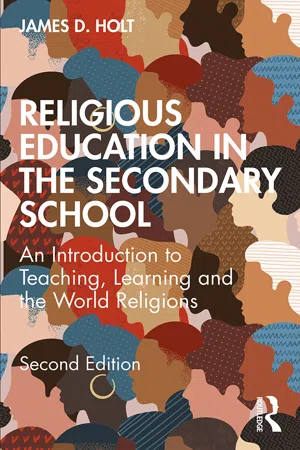
Religious Education in the Secondary School
An Introduction to Teaching, Learning and the World Religions
- 344 pages
- English
- ePUB (mobile friendly)
- Available on iOS & Android
Religious Education in the Secondary School
An Introduction to Teaching, Learning and the World Religions
About this book
Religious Education in the Secondary School is a comprehensive, straightforward introduction to the effective teaching of Religious Education (RE) in the secondary classroom. Acknowledging the highly valuable yet often misunderstood contribution of RE, this text shows how the subject can be taught in a way that explores the impact of religion on the lives of people and society, engaging pupils and preparing them to become individuals who celebrate and respect diversity.
This second edition has been thoroughly updated and includes a new chapter on 'Religion and Worldviews' and new material on the development and assessment of an RE curriculum. It is illustrated throughout with ideas for teaching at different key stages and offers expert chapters introducing you to both the World Religions and the core aspects of effective teaching and learning. With an emphasis on developing an understanding of the importance – and different ways – of meeting the learning needs of all pupils, key chapters cover:
• The nature of Religious Education.
• What is religion and worldviews?
• Understanding different pedagogies of RE.
• Effective planning and assessment.
• An approach to teaching across the Key Stages.
• Core subject knowledge in Buddhism, Christianity, Hinduism, Islam, Judaism and Sikhism.
Written by an experienced teacher, teacher educator and examiner, Religious Education in the Secondary School is a succinct compendium and has a real classroom applicability offering all trainee RE teachers, as well as those teaching Religious Education as specialists or non-specialists, a wealth of support and inspiration.
Frequently asked questions
- Essential is ideal for learners and professionals who enjoy exploring a wide range of subjects. Access the Essential Library with 800,000+ trusted titles and best-sellers across business, personal growth, and the humanities. Includes unlimited reading time and Standard Read Aloud voice.
- Complete: Perfect for advanced learners and researchers needing full, unrestricted access. Unlock 1.4M+ books across hundreds of subjects, including academic and specialized titles. The Complete Plan also includes advanced features like Premium Read Aloud and Research Assistant.
Please note we cannot support devices running on iOS 13 and Android 7 or earlier. Learn more about using the app.
Information
Part I
Introduction to Religious Education
Chapter 1
What is Religious Education?
The nature and purpose of Religious Education
The aims of Religious Education
- RE is bringing children up to be true to their own religion and culture.
- RE is helping children to develop their own ideas and values.
- RE is teaching children about the major religions of the world.
- RE is teaching children morals.
- RE is helping children to be tolerant in a multi-cultural society.
- RE is teaching children to accept Christian beliefs and values.
1 RE is bringing children up to be true to their own religion and culture
2 RE is helping children to develop their own ideas and values
Table of contents
- Cover
- Half Title
- Title Page
- Copyright Page
- Dedication
- Table of Contents
- List of figures
- List of tables
- Foreword
- Acknowledgements
- PART I: Introduction to Religious Education
- PART II: Planning in Religious Education
- PART III: Teaching and learning in Religious Education
- Index